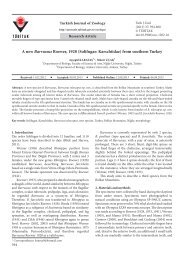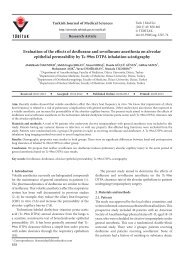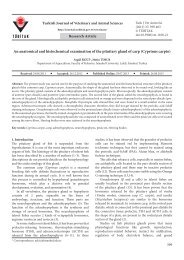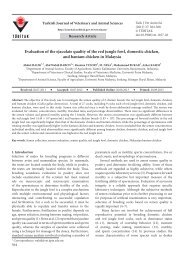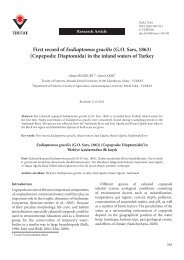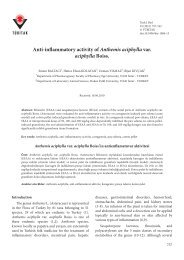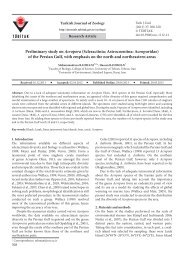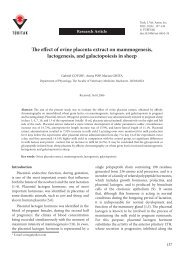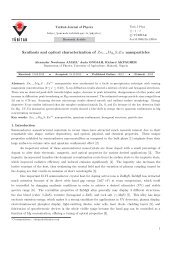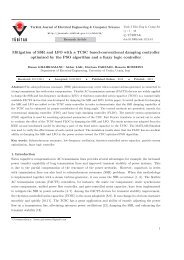Messinian forced regressions in the Adana Basin: a near ... - Tübitak
Messinian forced regressions in the Adana Basin: a near ... - Tübitak
Messinian forced regressions in the Adana Basin: a near ... - Tübitak
You also want an ePaper? Increase the reach of your titles
YUMPU automatically turns print PDFs into web optimized ePapers that Google loves.
<strong>the</strong> bas<strong>in</strong>. The post-Miocene deposits are fluvial terraces of<br />
coarse-gra<strong>in</strong>ed alluvium with caliche.<br />
The <strong>Mess<strong>in</strong>ian</strong> gypsum evaporites <strong>in</strong> <strong>the</strong> bas<strong>in</strong> are up to<br />
a few metres thick (Figure 3a) and <strong>the</strong>ir ma<strong>in</strong> varieties range<br />
from massive to lam<strong>in</strong>ated and enterolithic (Figure 3b),<br />
micro- to coarse-crystall<strong>in</strong>e (Figures 3c and 3d), nodular<br />
(Figure 3e), and wave-worked gypsarenitic (Figure 3f).<br />
X-ray diffraction data show that selenitic gypsum is <strong>the</strong><br />
sole evaporitic m<strong>in</strong>eral (Karakuş 2011). X-ray fluorescence<br />
analyses of major oxide composition <strong>in</strong>dicate that <strong>the</strong><br />
evaporitic precipitation occurred <strong>in</strong> homogeneous<br />
hydrochemical conditions, with a Sr-signature similar to<br />
<strong>the</strong> <strong>Mess<strong>in</strong>ian</strong> evaporites <strong>in</strong> adjacent peri-Mediterranean<br />
bas<strong>in</strong>s (Karakuş 2011).<br />
5. Facies architecture of deltaic members<br />
The study focuses on <strong>the</strong> 3 isolated conglomeratic members<br />
of <strong>the</strong> Handere Formation: <strong>the</strong> Muratlı, Tepeçaylak, and<br />
Sögütlü members (Figure 1c). They have been exhumed by<br />
Quaternary erosion and are laterally surrounded by sparsely<br />
preserved shallow-mar<strong>in</strong>e sandstones of <strong>the</strong> Handere<br />
Formation, with which <strong>the</strong>y sharply overlie <strong>the</strong> formation’s<br />
offshore mudstones (Figure 2). These conglomeratic<br />
members consist of 2 ma<strong>in</strong> facies associations, Gilberttype<br />
deltaic deposits and fluvial <strong>in</strong>cised valley-fill deposits,<br />
which are described and <strong>in</strong>terpreted <strong>in</strong> <strong>the</strong> present section.<br />
5.1. Gilbert-type delta deposits<br />
These conglomeratic deposits are generally well-bedded,<br />
form<strong>in</strong>g cl<strong>in</strong>oformal wedges that are stacked bas<strong>in</strong>wards<br />
<strong>in</strong> a downstepp<strong>in</strong>g pattern and are up to 15–40 m thick.<br />
The cl<strong>in</strong>oformal architecture consists of <strong>in</strong>cl<strong>in</strong>ed foreset<br />
beds overla<strong>in</strong> by horizontal topset beds (Figure 4a), as<br />
is generally characteristic of Gilbert-type deltas (Barrell<br />
1912; Colella 1988; Postma 1990).<br />
5.1.1. Foreset facies<br />
Foreset deposits are conglomerate and subord<strong>in</strong>ate<br />
sandstone beds <strong>in</strong>cl<strong>in</strong>ed bas<strong>in</strong>wards at up to 25°<br />
(Figure 4b). They show an overall coarsen<strong>in</strong>g-upwards<br />
trend and comprise facies commonly reported from<br />
Gilbert-type deltas (Postma 1984; Nemec et al. 1999;<br />
Lønne & Nemec 2004; Breda et al. 2007). Some outcrops<br />
show <strong>the</strong> foreset beds pass<strong>in</strong>g tangentially downdip <strong>in</strong>to<br />
<strong>the</strong> gently <strong>in</strong>cl<strong>in</strong>ed and f<strong>in</strong>er-gra<strong>in</strong>ed beds of delta toeset<br />
(Figure 4a). Conglomerate beds are 10–75 cm thick, but<br />
ma<strong>in</strong>ly 15–35 cm, and are tabular to mound-shaped. They<br />
consist of granule to coarse-pebble gravel and occasionally<br />
conta<strong>in</strong> scattered cobbles of up to 15 cm <strong>in</strong> size. The gravel<br />
is subrounded to rounded and has ma<strong>in</strong>ly a clast-supported<br />
texture (Figure 4c). Clasts are derived from <strong>the</strong> bedrock<br />
Mesozoic limestones and serpent<strong>in</strong>ite, and from <strong>the</strong> bas<strong>in</strong>marg<strong>in</strong><br />
Miocene reefal limestones. The matrix is moderately<br />
well-sorted sand with granules. Many conglomerate<br />
beds and <strong>the</strong> majority of associated sandstone beds<br />
ILGAR et al. / Turkish J Earth Sci<br />
show planar-parallel stratification (Figure 4b) <strong>in</strong>dicat<strong>in</strong>g<br />
tractional deposition from fully turbulent hyperpycnal<br />
flows (Bornhold & Prior 1990; Nemec 1990), which means<br />
river-generated low-density turbidity currents (sensu<br />
Lowe 1982). Massive conglomerate beds are nongraded or<br />
<strong>in</strong>versely graded (Figure 4d), tabular <strong>in</strong> dip section, and<br />
mound-shaped lenticular <strong>in</strong> strike section, <strong>in</strong>terpreted to<br />
be deposits of cohesionless debris flows (Nemec & Steel<br />
1984; Nemec 1990).<br />
Sandstones predom<strong>in</strong>ate <strong>in</strong> <strong>the</strong> down-dip part of <strong>the</strong><br />
foreset and at its toe, form<strong>in</strong>g tabular or wedge-shaped<br />
beds that are 5–30 cm thick, composed of very coarse- to<br />
f<strong>in</strong>e-gra<strong>in</strong>ed sand and alternat<strong>in</strong>g with th<strong>in</strong> beds of granule<br />
conglomerate (Figure 4a). Common are scattered pebbles<br />
of up to 5 cm <strong>in</strong> size. The sandstone beds show planarparallel<br />
stratification with or without normal grad<strong>in</strong>g<br />
and are often capped by current-ripple cross-lam<strong>in</strong>ation<br />
with down-dip transport direction. Some of <strong>the</strong> foreset<br />
beds, up to 40 cm thick, are isolated backsets of up-slope<br />
dipp<strong>in</strong>g cross-strata composed of coarse sand and/or f<strong>in</strong>epebble<br />
gravel (Figure 4e). They occur on <strong>the</strong> stoss side of<br />
mound-shaped massive conglomerate bodies (debris-flow<br />
deposits) or as <strong>the</strong> <strong>in</strong>fill of trough-shaped scours (deltaslope<br />
chutes). The backsets <strong>in</strong>dicate tractional deposition<br />
by low-density turbidity currents subject to hydraulic jump<br />
(Nemec 1990). There are also sporadic slump deposits of<br />
variable scale and thickness (Figure 4f).<br />
5.1.2. Topset facies<br />
The delta topset deposits (Figures 4a and 5) are pebble<br />
conglomerates and coarse-gra<strong>in</strong>ed sandstones. Their<br />
f<strong>in</strong><strong>in</strong>g-upwards bedsets, 60–140 cm thick, have erosional<br />
bases and are commonly stacked on top of one ano<strong>the</strong>r,<br />
apparently represent<strong>in</strong>g multistorey palaeochannels of<br />
braided streams a few metres wide (Coll<strong>in</strong>son 1996; Miall<br />
1996). Their laterally discont<strong>in</strong>uous basal layers of coarse<br />
clast-supported conglomerate are thought to be channelfloor<br />
lag deposits (Miall 1985; Nemec & Postma 1993).<br />
Planar parallel-stratified and cross-stratified beds, 10–45<br />
cm thick, are <strong>in</strong>terpreted, respectively, to be deposits of<br />
longitud<strong>in</strong>al and transverse or oblique midchannel bars<br />
(Miall 1985; Nemec & Postma 1993).<br />
The deltas suffered erosion and <strong>the</strong>ir topset deposits<br />
are <strong>in</strong>consistently preserved, generally better <strong>in</strong> <strong>the</strong><br />
upstream part (Figure 4a). The sparser downstream<br />
preservation of delta topset may be due to a negative<br />
subaerial accommodation (Bhattacharya & Willis 2001),<br />
or to removal by post-Miocene erosion (Figure 2). The<br />
relationship of <strong>the</strong> delta topset to <strong>the</strong> foreset is <strong>in</strong>variably<br />
oblique (erosional), which supports <strong>the</strong> notion of a fall<strong>in</strong>g<br />
delta-shorel<strong>in</strong>e trajectory (Breda et al. 2007, 2009) based<br />
on evidence that <strong>the</strong> horizontal topset was <strong>in</strong>crementally<br />
stepp<strong>in</strong>g down <strong>in</strong> <strong>the</strong> bas<strong>in</strong>ward direction, as discussed <strong>in</strong><br />
<strong>the</strong> next section.<br />
7



